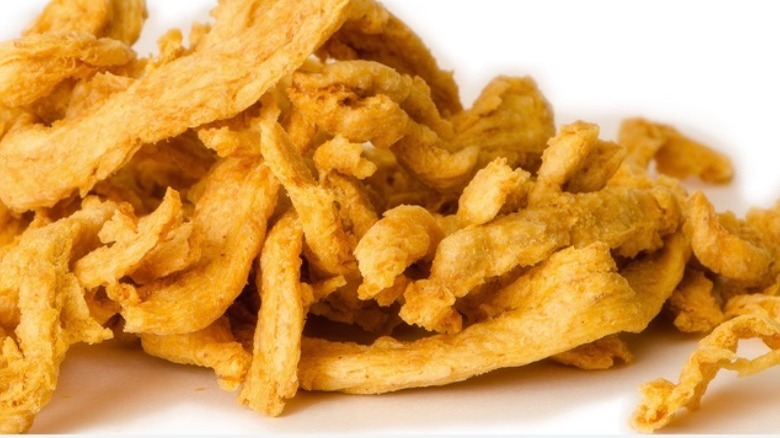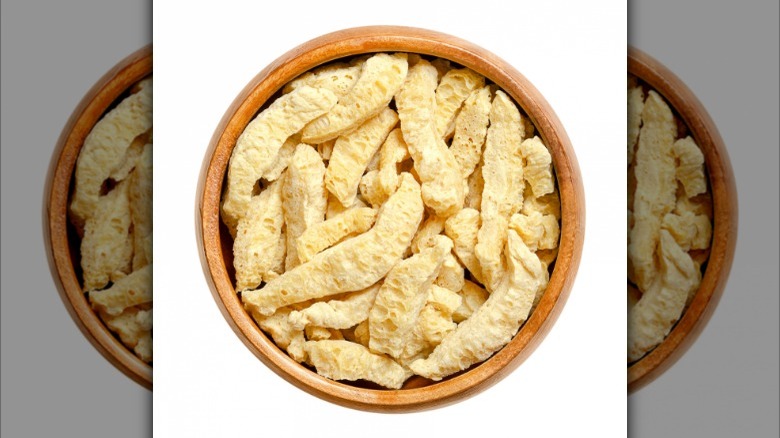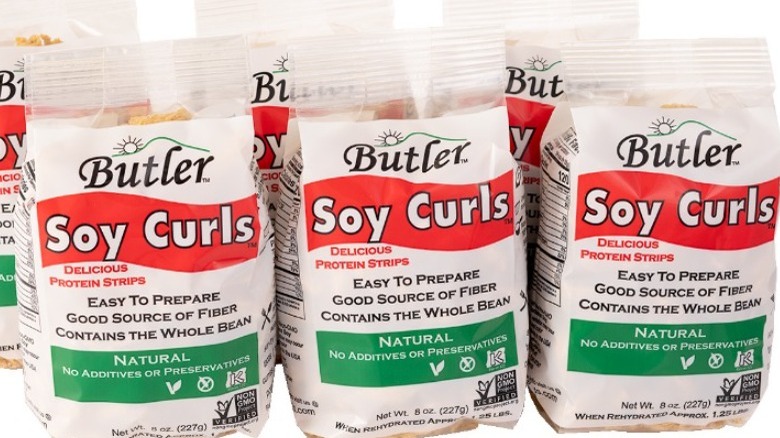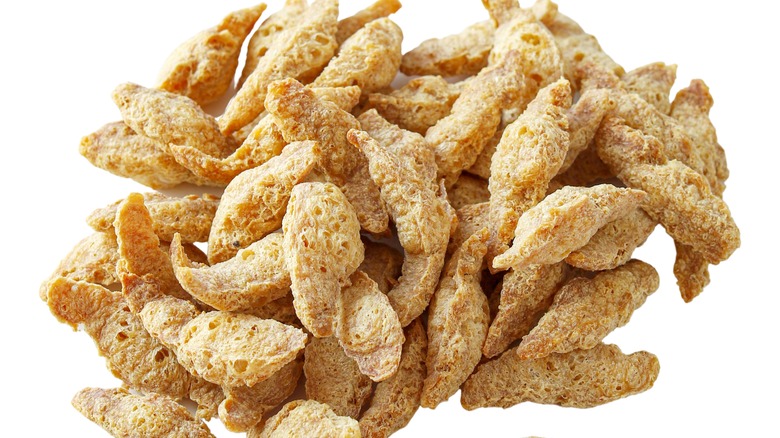What Are Soy Curls And How Can You Cook Them?
A meatless dish is not the ascetic choice many presume it to be. The alchemy that is cooking ensures that combinations of vegetables, fruits, grains, nuts, and beans deliver unlimited variety in the kitchen. In addition to the wide array of whole food ingredients available, there are plant-based meat options; some attempt to mimic the real thing through processing while others naturally offer similar protein and chew.
In the first category, there are burgers, meat and fish filets, sausage, hot dogs, and cold cuts, among others. Preparing a meat-free meal with them is a breeze and they can ease a transition to a more plant-focused diet, providing the comfort of familiar tastes and textures.
Demand for these products grew dramatically in the last decade, however, according to The Takeout, it's recently realized a sharp decline (via Bloomberg). The outlet cites consumer concerns around the nutritional and environmental soundness and the rising cost of groceries. The second group is minimally processed meat alternatives with a longer history of consumption. These include soy products such as tofu, tempeh, and Soy Curls.
Soy Curls are a great substitute for meat because they readily absorb the seasonings and sauces they're cooked in and the organic shapes look pretty convincing mixed into the recipe (via The Hidden Veggies). But that's not all, let's dive into the other benefits of this meat alternative.
What are Soy Curls?
Soy Curls are a natural, one-ingredient food made from whole soybeans. They're essentially dehydrated pieces (and flavor-absorbing sponges!) of soy that, once hydrated, can serve as a meat replacement. Yet, they're not to be confused with textured vegetable protein (also known as TVP, trademarked by Archer-Daniels-Midland Co. via Bob's Red Mill), which is "defatted soy flour" that is dehydrated and processed into pellets, chunks, or medallions.
Trademarked and sold by Butler Foods, a family-owned U.S. company, Soy Curls are made from soybeans that are soaked and cooked in spring water. The cooking liquid and beans are gently agitated during the process to encourage them to break down and the resulting emulsified mixture is forced through an extruder into strip-like curds.
Finally, the strips are slowly dried at a low temperature to preserve some of the benefits of the whole soybean, such as fiber and omega-3. Soy Curls have neither preservatives nor additives and therefore, the company suggests storing them in the refrigerator or freezer.
According to Bon Appétit, Soy Curls taste a bit like chicken, and I Am Going Vegan claims their texture is more spot-on than some products marketed as chicken substitutes. They also do a good job of emulating steak, ground beef, and pork. Without substantial original flavor, Soy Curls are highly dependent upon seasonings in recipes, which makes them a perfect meat alternative in dishes where they would be a supporting component, like salad, soup, stir-fry, pasta, and tacos.
How to cook with Soy Curls
Most recipes require Soy Curls to be soaked in liquid to plump and soften them; using broth, seasoned plant milk, or a marinade will impart flavor. Per Butler Foods, after the Soy Curls have been immersed for approximately 10 minutes, you'll want to squeeze them to remove the excess moisture before proceeding with the recipe. They'll be about twice the size they were prior to hydration.
According to My Quiet Kitchen, some dishes call for Soy Curls in or close to their dried state. Placing them directly into a stew encourages them to absorb its seasonings; likewise, coating them in a small amount of marinade ensures they'll be toothsome, rather than soggy. Further, Soy Curls can be tossed in spices, coated and fried, baked, and warmed in broth.
Browning them in oil adds texture and flavor complexity; with that in mind, ingredients with natural sugars, such as BBQ sauce, maple syrup, and tomato paste give them a boost of caramelization and a crust reminiscent of seared meat.
The Hidden Veggies suggests separating them by size for particular uses, for example, larger pieces are featured in fajitas, medium in soups and stews, and the tiniest bottom-of-the-bag leftovers are best for meatballs.
Where to buy Soy Curls
Soy Curls can be found at markets and food co-ops, although with limited availability. They can also be purchased online directly from Butler Foods or from various online retailers such as Amazon and Walmart. If you order from Butler Foods, six 8-oz. bags are $24.09 plus $11.00 for shipping, which is a few dollars cheaper than Amazon.
Some co-ops sell Soy Curls in bulk, allowing you to purchase the exact amount you need. Typically, buying bulk goods offers an economic benefit, plus they can be placed straight into storage containers, skipping the usual packaging and the connected costs.
With that in mind, a 12-pound bulk box of Soy Curls from Butler Foods is $57.69 and $15 to ship. While they're shelf-stable for a long time per The Hidden Veggies, the larger amount could prompt a joint purchase (old school coop style) with a friend or family member; and you could share recipes, too.
Nutritional information
Soy Curls are made with just soybeans and water. While not totally pure, they are minimally processed. Even though red flags have been raised regarding soy's link to breast cancer, the danger has been largely debunked after several studies, and in some cases, there may even be a decreased risk associated with a diet high in soy consumption (via WebMD). While the effects of processed soy products are more inconclusive, Dr. Denise Millstine asserts that whole soy foods are safe when consumed as part of a healthy and balanced diet.
Soy is a complete protein, which means it contains all of the nine essential amino acids that our bodies can't manufacture on their own, per WebMD. Additionally, as listed on the Butler Foods site, Soy Curls provide a decent amount of protein, fiber, iron, potassium, and a small degree of healthy fat.
What they don't include is a long list of potentially unhealthy ingredients such as preservatives, chemical additives, protein isolates, and added salt, sugar, or oil that other meat alternatives often do. As a plus for those with gluten sensitivities, they're also gluten-free.




